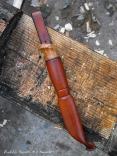Would you like to make your own knife and/or sheath but don’t have the tools or experience?
You can come to my Brighton workshop and learn to do it yourself, please follow this blog for pricing announcements or drop me a line.
A while back I ran a series of 1-2-1 workshop sessions with Jess who wanted to make a handle and sheath for a blade she had previously forged on a knife making course elsewhere.
The black stick tang blade had a very nice hand made rustic quality about it with hammer marks from it’s forging still viable along the blade and spine.
Our first session was spent discussing the intended uses of the knife, what she would like it to look like and choosing the materials we would use. She wanted something to use as a general purpose tool for the various crafts she was pursuing as well as something she could take camping with her.
The blade has the look of an old eating knife but due to it’s thickness would lend itself to other tasks well.
We explored various material combinations that would compliment the black blade and eventually settled on using Bog Oak and Saddle Tan leather for the handle and sheath and a factory made Brass cup style ferrule for the tang to pass through.
We looked at various styles of handle and sheath in search of something that would compliment the slender blade before she settled on a somewhat Scandinavian design with an exposed wooden liner. To compliment the faceted forged look of the blade it was decided that the handle and wooden liner would look best if they had a carved finish rather than sanded smooth.
Over the next few months she came to my workshop to make the handle and sheath, occasionally asking for advice or instructions for the next stage of the process.
The first step was to drill out and file a slot in the handle material to fit the tang of the knife and then carve a step fro the ferrule to key onto (the wood of the handle extends up inside the brass ferrule), these are perhaps the mod laborious tasks requiring careful use of hand tools.
Once the slot was finished and the ferule fitted the three components were glued together and work could begun on shaping the handle.
 Please note the blade is blunt at this stage and was wrapped with thick tape while work was done on the handle despite what is shown in the image below.
Please note the blade is blunt at this stage and was wrapped with thick tape while work was done on the handle despite what is shown in the image below.

The handle begins to take shape.

The knife is taking shape…
 After several more sessions that I wish were documented in photographs the knife and sheath were finished.
After several more sessions that I wish were documented in photographs the knife and sheath were finished.
 The Vegetable Tanned leather was wet formed around the knife and wooden liner and stitched while still damp, this ensures a tight fit as the drying leather shrinks into place.
The Vegetable Tanned leather was wet formed around the knife and wooden liner and stitched while still damp, this ensures a tight fit as the drying leather shrinks into place.
 The carved Bog Oak handle compliments the black steel blade.
The carved Bog Oak handle compliments the black steel blade.
 Careful use of the whittling knife was required to ensure a smooth transition from the ferrule to the handle.
Careful use of the whittling knife was required to ensure a smooth transition from the ferrule to the handle.
 The exposed Bog oak liner matches the texture of the handle and echoes the faceting of the blade. Held firmly in place by the wet formed leather and a little glue it provide protection for and from the blade.
The exposed Bog oak liner matches the texture of the handle and echoes the faceting of the blade. Held firmly in place by the wet formed leather and a little glue it provide protection for and from the blade.
 The edges of the leather were bevelled, sanded smooth and burnished until shiny to ensure a long lifespan. The belt loop is made from a twisted leather thong and requires no stitching or glueing, this makes it easy to replace in years to come while providing a secure fastening during use.
The edges of the leather were bevelled, sanded smooth and burnished until shiny to ensure a long lifespan. The belt loop is made from a twisted leather thong and requires no stitching or glueing, this makes it easy to replace in years to come while providing a secure fastening during use.
Securing the thong is a knot where the leading end passes through a slot in the leather, this locks as the knot gets tight er meaning it will not come undone.
er meaning it will not come undone.
The top part of the sheath grips the handle to prevent the knife falling out, when returning the knife it clicks into place indicating it is secure.

After much careful work the finished knife became something to be proud of, an elegant and durable tool to treasure and use.



























